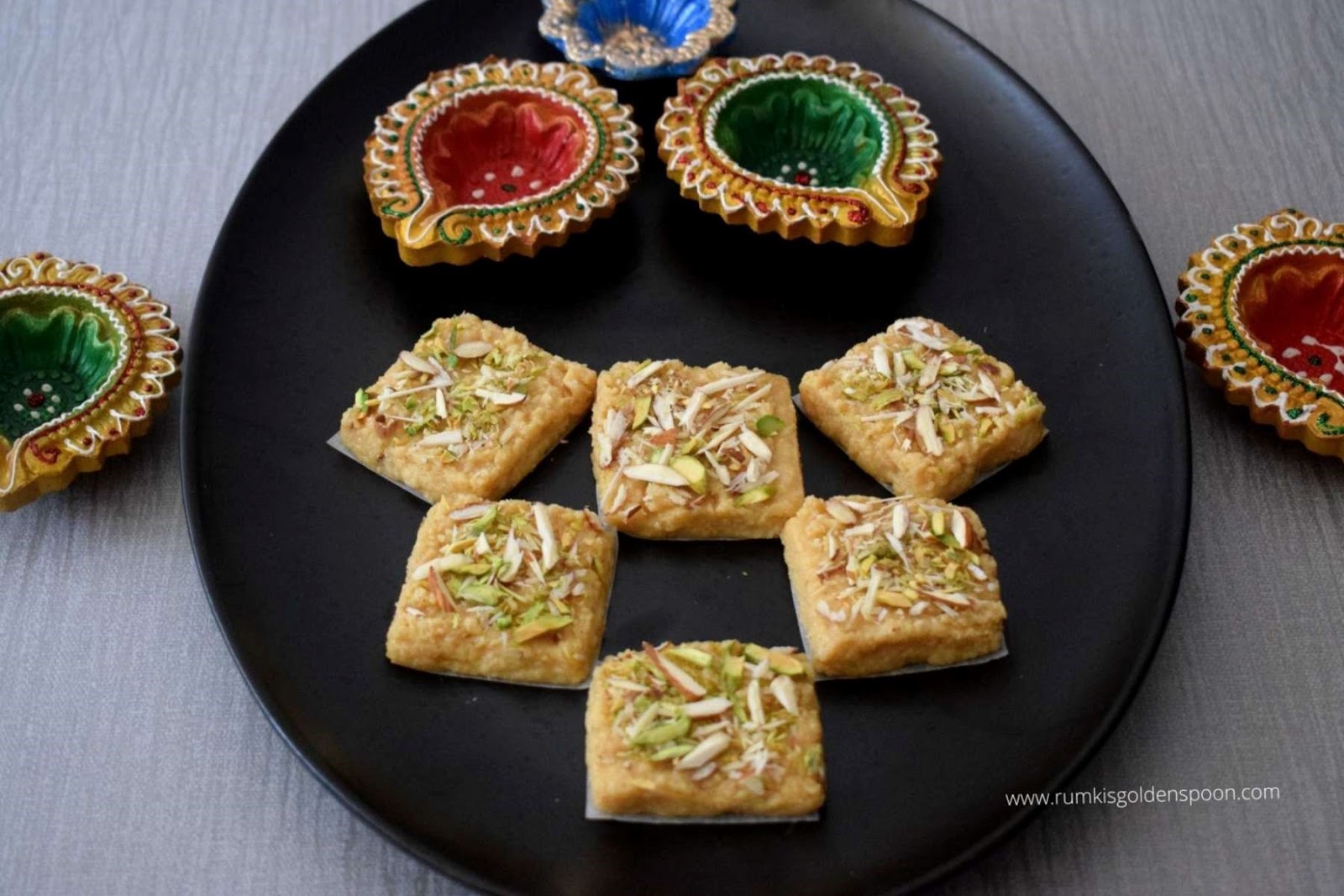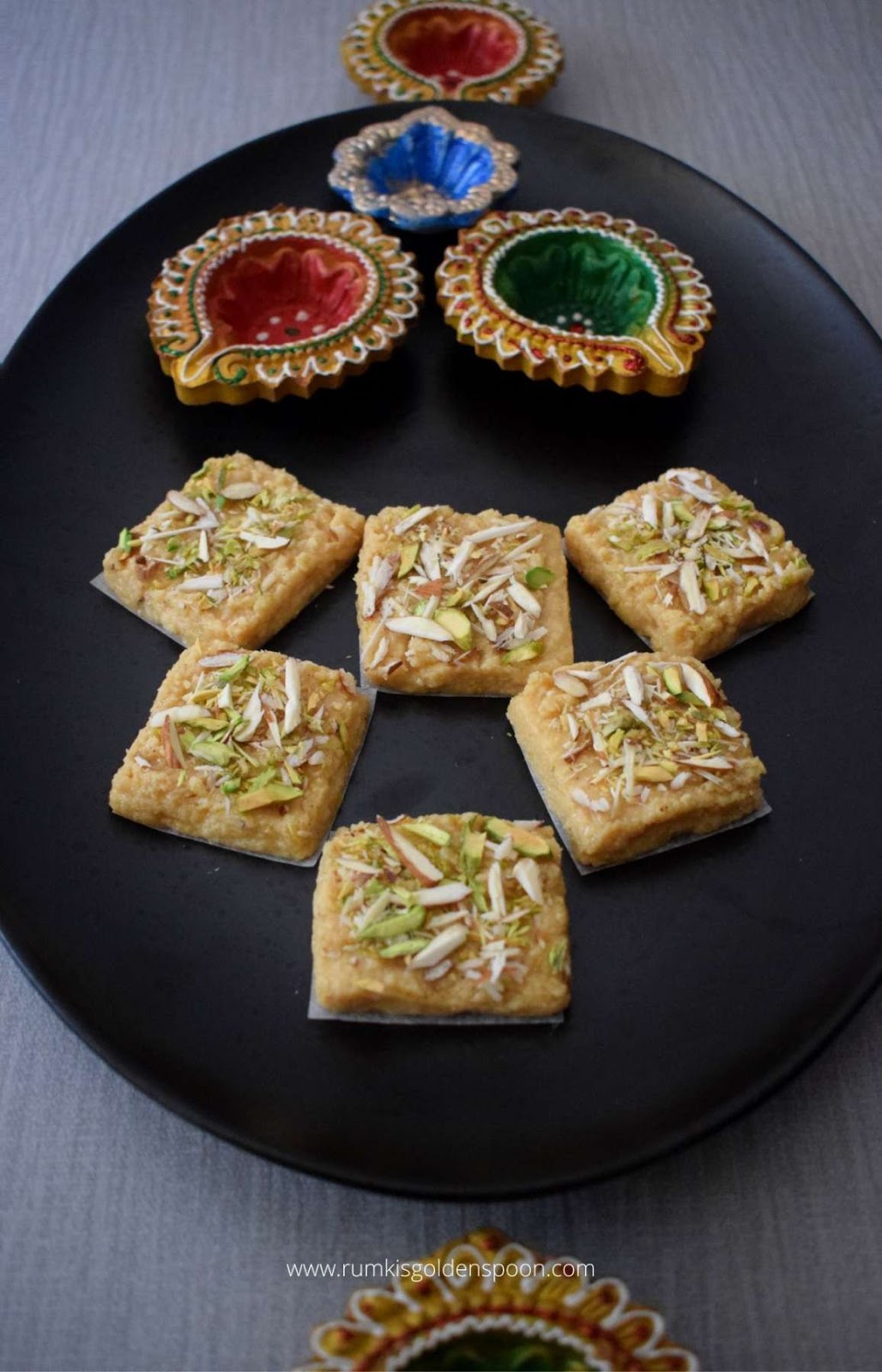8.2K

Kalakand recipe
How to make Kalakand?

Ingredients:
Instructions:
Serving Instruction
Indian sweet recipes play an important role in Indian culture. For Indians, any festival or ceremony is incomplete without sweets. In fact, if someone is successful on something or has any good news then they celebrate their joy by sharing sweets with their close ones. When all these occasions are celebrated with homemade sweets, every occasion becomes more special and emotional.
Since my childhood, I have seen my mom and aunts to prepare different ranges of sweets for various occasions. From Sankranti to Diwali, they are always on to prepare sweets in their kitchen. Till now, I have eaten more than hundreds of varieties of sweets prepared by my mom. Each year, during Sankranti or Laxmi Puja, I have seen her preparing at least fifteen different varieties of sweets. She starts preparing sweets from early morning and completes her job by the evening.
Recipe for Kalakand is perfect dessert for any occasion. Kalakand recipe is a complete life saviour for all the housewives who encourage home cooking. Kalakand is a super easy and simple recipe. It only requires few basic ingredients to get prepared. The best part is that though it is an easy recipe but still it tastes extraordinary and supreme.
The Kalakand Mithai recipe that I have shared with you is neither the traditional version nor the instant one. But I will surely share both the versions with you shortly. This Kalakand recipe is my own variation. If you are running out of time, nothing can be a better option than this recipe.
The traditional Kalakand recipe takes a long time to get prepared because the milk reduction process is quite time consuming and you can’t go for any shortcut during this process. If you try to reduce the milk in highest flame, then it will get stuck to the bottom and induce a smoky flavour in milk which will be a disaster for preparing the Kalakand.
One day, I had invited one of my friend’s family for dinner and had completed my cooking except for the dessert. I was running out of time and checked my pantry. Luckily, I got some milk and lemon in my fridge and I also had a can of evaporated milk in my shelf. Hence, without losing a single moment, I prepared the Kalakand. My friend and her family loved the dessert and praised me a lot.
Now Kalakand has become one of our family hits and I frequently prepare this dessert at home. Till now, I have prepared different ranges of Kalakand and for me every version tastes unique and is equally delicious too.
Recipe for Kalakand with step by step photos and instructions have been provided in the ‘Instructions’ section of the recipe. But before directly jump into the recipe, let me share few interesting facts about the recipe.
Kalakand recipe
Kalakand recipe is a traditional Indian sweet recipe which is also known as Indian Milk Cake. Kalakand is prepared in different variations like Traditional Kalakand, Paneer Kalakand, Instant Kalakand or Kalakand recipe with condensed milk and every variation of it tastes divine.
Recipe for Kalakand is prepared in different ranges all over the country. Elaichi Kalakand, Gur Kalakand, Rose Kalakand, Gajar Kalakand, Mango Kalakand are few of the most popular versions of the classic Indian dessert recipes.
How to make Kalakand?
For Kalakand recipe, first I have curdled the milk to prepare Chenna. I have used lemon juice to curdle the milk. You can also use yogurt or vinegar for the same. After preparing Chenna, I have drained away the water in a colander lined with muslin cloth. Then I have washed the chenna lightly to remove the lemon flavour from it. After that, I have hung it for half an hour to extract the excess water. Then, I have crumbled the Chenna nicely before cooking.
For traditional Kalakand recipe, you can also prepare evaporated milk at home like. For that, you need to use full fat milk and boil it. After that, reduce its volume to one third at medium flame with frequent stirring. This way evaporated milk can be prepared at home. Though it would be a bit time consuming but would give you the same result.
In the recipe for Kalakand, I had a can of evaporated milk in my pantry and I have used it to save the time and effort to prepare the dish. One thing that I would like to mention it here is that evaporated milk and condensed milk are not the same. Evaporated milk is completely sugar free whereas condensed milk contains pretty good amount of sugar in it.
First, I have added the evaporated milk into the pan and then added the crumbed Chenna into the pan. After some time, I have added cardamom powder and sugar into the pan and mixed it thoroughly.
In the Kalakand recipe, I have used cardamom powder as a flavouring agent. The flavour of cardamom goes outstanding with this dessert.
It is very important to patiently cook the mixture slowly in medium flame. The mixture will become thicker gradually. Cook it until it becomes heavy mass and separates from the sides.
After preparing the mixture, I have set it on a greased tray. You can also use a plate for this. I have then spread it evenly with the help of a rubber spatula and sprinkled some cardamom powder and chopped nuts on the top. Then I have allowed it so to set in the refrigerator.
For the recipe for Kalakand, I have sprinkled finely chopped Pistachios and Cashews as toppings. You can add any of your preferable dry nuts like Almonds, Walnut etc.
Many recipe for Indian sweet have already been shared in my previous posts. You can check few of them like
..And Many more…
Ingredients:
- Full cream Milk, 1 Litre
- 1 Lemon
- 100 Gram unsweetened Evaporated Milk
- ½ Cup Sugar
- ¼ teaspoon Cardamom powder
- 4-5 Cashews, finely chopped for garnishing
- 5-6 Pistachios, finely chopped for garnishing
- 1 pinch of Cardamom powder, for garnishing
- 1 teaspoon Ghee, to grease the tray or plate
Instructions:
- Take 1 litre milk in a heavy bottom pan.
- Put the flame in medium high and let the milk boil.
Tip: While boiling the milk, put the flame in medium and stir occasionally. Otherwise, the milk will stick to the bottom of the pan and a burning smell may get induced into the milk.
- Put the flame in lowest.
- On the other side, cut the Lemon into two pieces.
- Squeeze out the Lemon juice in a bowl. Make sure there are no pulps and seeds in the juice.
- Add the Lemon juice slowly into the milk (Step 3).
- Stir it slowly and let the milk curdle.
- Stir for 1-2 minutes in lowest flame.
- On the other hand, place a colander in the sink of kitchen and put a Muslin cloth on the colander.
- While the water gets separated from the curdled milk, switch off the flame.
- Pour the curdled milk immediately to the Muslin cloth. With the help of a spatula, stir the Chenna gently for a minute to cool it off.
- Gather the corners of the cloth.
- Put the Chenna into the running water. Wash the Chenna carefully. This helps to remove the flavour of Lemon off the Chenna and allow the Chenna to cool down.
- Squeeze the excess water and then tie a tight knot of the cloth.
- Hang the Chenna for 30 minutes.
- Crumble the Chenna nicely.
- On the other hand, grease a tray or plate with Ghee and keep it aside.
- Now put a non-stick pan on a flame and put the flame in low.
- Pour evaporated milk into the pan and let it become warm.
- Add the crumbled Chenna into the pan and give a nice mix.
- Cook it in medium low flame and stir the mixture frequently with the help of a spatula or else the Chenna may stick to the pan. I have used rubber spatula for the recipe.
- Add cardamom powder and give a nice stir.
- Add sugar into the pan and mix it nicely until the sugar melts.
- The Kalakand mixture gets thick gradually.
- Cook it for 12-15 minutes until the mixture converts into a thick mass and separates from the sides.
- Switch off the flame and put the pan down.
- Pour the mixture into the greased tray (Step 17).
- Spread the mixture evenly ½ to 2/3-inch-thick by tapping and shaking the tray.
- Sprinkle a pinch of cardamom powder and some finely chopped nuts over the kalakand mixture.
- Keep the tray aside for an hour and allow it to reach to the room temperature.
- Keep it refrigerated for couple of hours so that it sets properly.
- Slice the Kalakand with the help of a knife.
Serving Instruction
Serve the Kalakand chilled or at room temperature to enjoy the best taste. Take the pieces of Kalakand out on a serving plate and enjoy the delicacy of Indian sweets.

2 comments
It was nice to go through your post. Thanks for sharing the recipe here. Keep up the good work.
Thank you for your kind feedback. I am glad that you liked it.